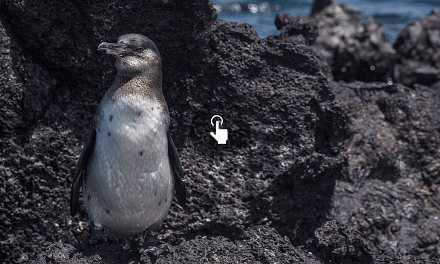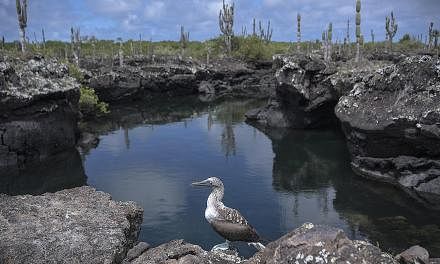When El Nino's winds of change blow strongly across the Pacific Ocean, a trail of destruction tends to follow.
On the western boundary of the world's largest ocean basin sits Singapore and the rest of the maritime continent, while to the east lies the Americas.
Neither escapes the scourge of El Nino.
For when the winds of change blow and the ocean churns in acquiescence, El Nino can scar South-east Asia with fire and haze. Yet, across the Pacific Ocean, El Nino brings rain so intense to the arid coasts of South America that lakes form in deserts.
The see-saw impacts seem like a bundle of contradictions, not unlike the phenomenon itself.
El Nino is one of the world's largest natural climate cycles, caused by changes to wind patterns and the swirl of ocean currents. El Nino is Spanish for "the little boy", but the havoc it can wreak is far from child-like.
In 2015, for example, the El Nino event caused South-east Asia to suffer its worst haze episode on record.
It brought drier weather to the region, causing the smoke-belching forest fires in Indonesia to burn harder and longer.
The World Bank estimated that the fires cost Indonesia more than US$16 billion (S$21.9 billion), and studies have shown that the pollution caused 100,000 early deaths in Indonesia, Malaysia and Singapore.
The 2015 event was the most recent strong El Nino event, and is considered one of the three largest ones to have occurred in the past five decades.
In 1982 and 1997 also, strong El Ninos reared their heads, affecting not only South-east Asia but also nearly wiping out populations of unique animals, such as the world's only equator-dwelling penguins 18,000km away on Ecuador's Galapagos Islands.
This year is an El Nino year, too, according to the United States National Oceanic and Atmospheric Administration.
While El Nino is a natural phenomenon that would occur regardless of human-caused climate change, some studies have shown that it could become more intense and frequent as the world warms.
Insight travelled to Riau in Indonesia and the Galapagos in Ecuador with the support of the University of California's Scripps Institution of Oceanography to take a look at El Nino and its impact - ranging from changing rainfall patterns to warming seas, that could offer a glimpse into what things would be like in a warming world.
THE BOY CHILD
Like the tantrums of a petulant child, the destruction that El Nino has wrought in recent decades has made the world sit up and pay more attention.
The 1982 event, in particular, was a turning point. That year, El Nino caused a global catastrophe - droughts in the western Pacific and beyond, going as far west as Africa and India - and it dumped huge amounts of rain in Ecuador and northern Peru.
That event also resulted in one of the first in-depth reports of El Nino in the mainstream media. In February 1984, the National Geographic ran a multi-page report documenting the impacts of the 1982 El Nino.
But El Nino is not a new phenomenon. Centuries ago, Peruvian fishermen observed a periodic warming of the ocean along the South American coast - usually a rich fishing ground - which emptied their nets of fish.
As this usually occurred around Christmas, they named the phenomenon El Nino, a reference to the birth of Jesus Christ.
Mr Rodney Martinez, international director for the International Research Centre on El Nino, or Ciifen, says the term has since been "kidnapped" by the scientific community.
It was not a bad thing, he says, although it may cause confusion since the same name was also used to refer to phenomena of different scales.
"For Peruvians and Ecuadorians, El Nino is a local event that happens when there is a sustained warming of the ocean that brings heavy rainfall in some places," he tells The Sunday Times at his office in Guayaquil, Ecuador.
Today, El Nino is better known by the international community as a global phenomenon, with a footprint spanning the tropical Pacific Ocean. It can also affect weather beyond the Pacific basin through links known as teleconnections.
On a broader scale, El Nino refers to the warm phase of the El Nino-Southern Oscillation, one of the world's largest natural climate cycles that influences sea surface temperatures and rainfall patterns.
The cool phase, known as La Nina, has an opposite effect - causing more rain in the west, and drier conditions in the east.
Both El Nino and La Nina cause changes to rainfall patterns. But El Nino events can be more destructive.
As the Pacific Ocean warms, it energises the ocean, charging up the atmosphere and affecting rainfall patterns, says Dr Xie Shang-Ping, a climate modeller and El Nino expert from Scripps.
"The atmosphere just doesn't respond as strongly to La Nina as it does to El Nino," he says.
Today, the observations of the Peruvian fishermen are still valid, illustrating the link between sea surface temperatures and rainfall patterns.
It is, after all, this coupling between the ocean and the atmosphere that determines the strength of an El Nino.
THE CLIMATIC SEE-SAW
The Pacific Ocean is the largest ocean basin on Earth. Unsurprisingly, it is not a uniform body of water, and the differences influence the climate of various regions.
Under normal conditions, the western Pacific is much warmer than the east.
The reason lies in the way the winds blow.
In the tropical Pacific Ocean, winds mainly blow from east to west. These predictable trade winds, as they are known, keeps warm water confined around the maritime continent.
The waters warm as they move across the Pacific Ocean, eventually pooling around the maritime continent. Says Dr Xie: "Evaporating warm water fuels the rain clouds in the western part of the tropical Pacific. That explains why Singapore and Indonesia are blessed with a lot of rainfall."
Things are different in the east.
When the trade winds blow, they push water away from the South American coast. This causes water from the depths of the ocean to well up towards the surface.
Deep waters are cooler, and they contain many nutrients from sinking organic matter.
As they move to the surface, they stimulate the oceanic food web. This upwelling is one of the reasons why some of the world's richest fisheries can be found along the South American coast.
But cooler waters also cool the atmosphere above it, causing air to sink and creating an area of high pressure. This makes it harder for rain clouds to form.
When an El Nino hits, on average every three to four years, it disrupts this status quo. Scientists believe the weakening of the trade winds may be what kick-starts this process, although the exact trigger is still being studied.
As the trade winds weaken, the pool of warm water in the west is no longer confined to that region, and a tongue of warm water now extends from west to east.
As the warm water moves towards the central and eastern Pacific Ocean, the rain clouds follow.
Reducing impact of extreme events
More warm water in the east pushes the cooler waters to deeper depths, and what upwells to the surface is warm water. This reinforces the original change, and is why El Nino impacts can stretch over months.
As the oceans warm and heavy rain falls, native wildlife in the eastern Pacific can be severely affected.
In the Galapagos Islands, birthplace of Charles Darwin's Theory of Evolution, the population of the world's only equator-dwelling penguins was almost wiped out in the aftermath of the 1982 El Nino.
The event had cut off the supply of nutrient-rich deep, cool water, causing a collapse of the oceanic food web and organisms reliant on it, such as the penguins.
Says Charles Darwin Research Station sea bird researcher Gustavo Jimenez: "On average their numbers range between 2,000 and 4,000 penguins, but after that event, we counted just 300."
CLIMATE CHANGE LINK
El Nino, with its wide reach across the Pacific Ocean and beyond, has affected human lives, livelihoods and biodiversity.
Assistant Professor Winston Chow, a climate scientist at the National University of Singapore, says there are certain analogies to climate change that can be drawn from these events.
"Some aspects, such as increased atmospheric warmth and sea surface temperatures, can be useful examples of equivalent climate change conditions," says Prof Chow, who is also a lead author for an upcoming report by the Intergovernmental Panel on Climate Change (IPCC).
El Nino events provide a natural "stress test" to see how human and natural systems deal with the changes, and the adaptation measures that can be taken, he says.
Ciifen's Mr Martinez agrees, saying: "If we prepare for the impacts of El Nino, we are also working to mitigate the impacts of extreme events, which are the strongest evidence of climate change."
Singapore, for instance, is preparing to deal with drought by investing in weatherproof sources of water, such as desalination, and Newater, or recycled used water.
Other countries, such as Indonesia and the Galapagos Islands - ground zero for El Nino - are doing the same, as The Sunday Times recently discovered on two reporting trips across the Pacific Ocean.
One strategy for both archipelagos is the protection of natural ecosystems, such as sprawling tropical rainforests and peatlands, and pristine habitats on the Galapagos.
Says Mr Martinez: "In our experience, grey infrastructure does not solve the problem. They just shift the impact somewhere else."
Seawalls built along a river, for example, may protect a city from being flooded, but not an area further downstream. "However if you manage the degradation of the riverine ecosystem, if you keep the vegetation, the river can retain water better, reducing the possibility of floods overall," says Mr Martinez.
The interconnectedness of the global climate system and economy all point to the importance of climate action by all.
Says climate scientist Michael Mann from the Pennsylvania State University: "El Nino touches just about every continent, including the United States, Eurasia, Africa, Australia. And because we live in an interconnected global economy, extreme impacts in one region can... cause global spikes in prices of commodities and food."
Indeed, Dr Xie notes that models used to project the intensity of El Nino have been inconsistent.
But what is clearer is how climate change will affect rainfall patterns - a major impact of El Nino, says Dr Xie.
He says: "During El Nino years, countries in the West Pacific could experience drier weather that could lead to droughts and wildfires, whereas those in the central and eastern Pacific could experience more rain - causing flash floods and the spread of diseases."
Natural El Nino events can change rainfall patterns drastically - but so can human-caused climate change.
The IPCC had in its latest report highlighted precipitation variability and extremes as a key risk that could affect food insecurity and other aspects of human life.
In a way, the impacts of severe El Nino events offer a glimpse into what things could be like in a warming world.
There is, however, a key difference.
While the effects of El Nino are temporary, usually ending after a few months, unabated global warming could well drive permanent change and destruction.








